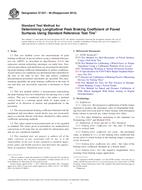Potřebujeme váš souhlas k využití jednotlivých dat, aby se vám mimo jiné mohly ukazovat informace týkající se vašich zájmů. Souhlas udělíte kliknutím na tlačítko „OK“.
ASTM E1337-90(2012)
Standard Test Method for Determining Longitudinal Peak Braking Coefficient of Paved Surfaces Using Standard Reference Test Tire
Automaticky přeložený název:
Standardní zkušební metoda pro stanovení Podélný Peak brzdový Koeficient zpevněného povrchu pomocí standardních referenčních testech pneumatik
NORMA vydána dne 1.12.2012
Informace o normě:
Označení normy: ASTM E1337-90(2012)
Poznámka: NEPLATNÁ
Datum vydání normy: 1.12.2012
Kód zboží: NS-41354
Počet stran: 5
Přibližná hmotnost: 15 g (0.03 liber)
Země: Americká technická norma
Kategorie: Technické normy ASTM
Kategorie - podobné normy:
Anotace textu normy ASTM E1337-90(2012) :
Keywords:
ICS Number Code 93.080.20 (Road construction materials)
Doplňující informace
| Significance and Use | ||||||||||||||
|
5.1 Pavement surfaces have different traction characteristics, depending on many factors. Surface texture, binder content, usage, environmental exposure, and surface conditions (that is, wet, dry) are some of the factors. 5.2 The measured values represent peak braking coefficients for tires of the general type in operation on passenger vehicles, obtained with a towed test trailer on a prescribed road surface, under user defined surface conditions. Such surface conditions may include the water depth used to wet the road surface and the type of water application method. Variations in these conditions may influence the test results. |
||||||||||||||
| 1. Scope | ||||||||||||||
|
1.1 This test method covers the measurement of peak braking coefficient of paved surfaces using a standard reference test tire (SRTT) as described in Specification E1136 that represents current technology passenger car radial tires. General test procedures and limitations are presented for determining peak braking coefficient independent of surface conditions. Actual surface test conditions are determined and controlled by the user at the time of test. Test and surface condition documentation procedures and details are specified. This measurement quantifies the peak braking coefficient at the time of test and does not necessarily represent a maximum or fixed value. 1.2 This test method utilizes a measurement representing the peak braking force on a braked test tire passing over a road surface. This test is conducted with a tire under a nominal vertical load at a constant speed while its major plane is parallel to its direction of motion and perpendicular to the pavement. 1.3 The measured peak braking coefficient obtained with the equipment and procedures stated herein may not necessarily agree or correlate directly with those obtained by other surface coefficient measuring methods. 1.4 The values stated in inch-pound units are to be regarded as standard. The values given in parentheses are mathematical conversions to SI units that are provided for information only and are not considered standard. 1.5 This standard does not purport to address all of the safety concerns, if any, associated with its use. It is the responsibility of the user of this standard to establish appropriate safety and health practices and determine the applicability of regulatory limitations prior to use. |
||||||||||||||
| 2. Referenced Documents | ||||||||||||||
|
Doporučujeme:
Aktualizace technických norem
Chcete mít jistotu, že používáte pouze platné technické normy?
Nabízíme Vám řešení, které Vám zajistí měsíční přehled o aktuálnosti norem, které používáte.
Chcete vědět více informací? Podívejte se na tuto stránku.




 Cookies
Cookies
